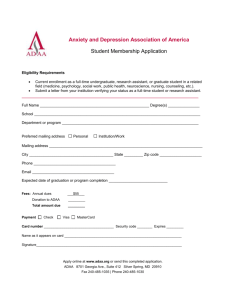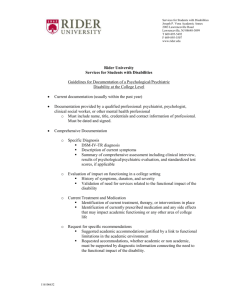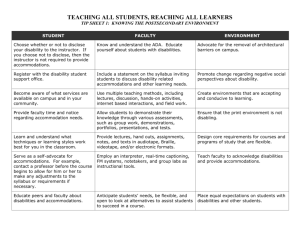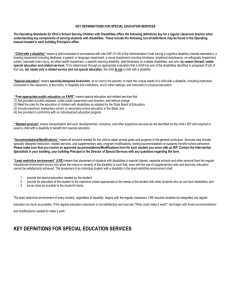Chapter 5
advertisement
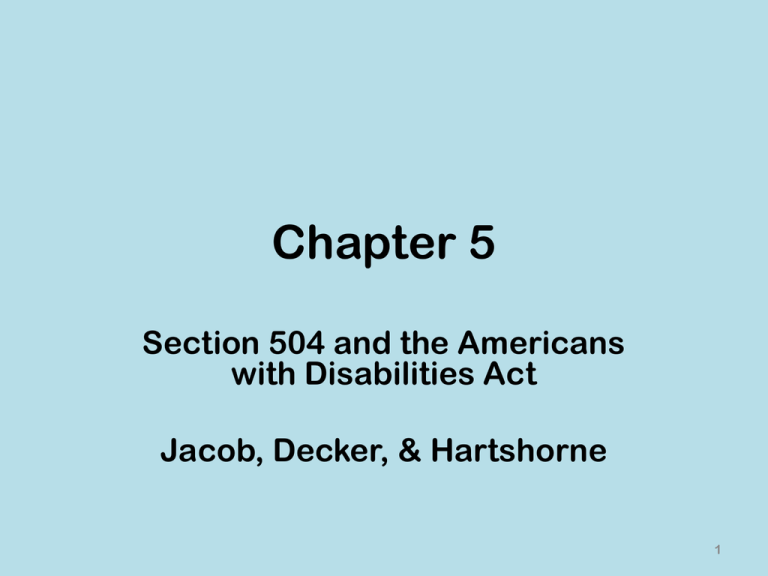
Chapter 5 Section 504 and the Americans with Disabilities Act Jacob, Decker, & Hartshorne 1 The Rehabilitation Act of 1973 Section 504 of The Rehabilitation Act of 1973 states: “No otherwise qualified handicapped individual in the United States…shall, solely by reason of his handicap, be excluded from the participation in, or be denied the benefits of, or be subjected to discrimination under any program or activity receiving Federal financial assistance.” 2 IDEA vs. 504 • Federal funds are provided under IDEA to each state that develops an acceptable plan to offer a free and appropriate education to all children with disabilities within the state. • Compliance with IDEA is monitored by the Office of Special Education Programs (OSEP) at the level of the state. 3 Section 504 • School districts must comply with 504 if they receive any federal funds for any purpose. • The Office of Civil Rights (OCR) monitors compliance with 504 by responding to complaints including complaints from individuals. • OCR may remove federal funds from a district not in compliance with 504. 4 IDEA v. 504 • Children who qualify as having a disability under IDEA also are protected by 504/ADAA. • The Americans with Disabilities Amendments Act of 2008 (ADAA) restored the original broad definition of impairment under 504/ADAA that had been narrowed by case law. • Obligations under 504 are “broader but shallower” than IDEA. 5 Ups and Downs of 504 • Passed in 1973, but initially ignored. • In 1980s, OCR enforcement activities, court decisions, and parent advocacy efforts resulted in heightened awareness of Section 504. • With IDEA 1997 and 2004 changes, 504 may become less important as a means of ensuring educational accommodations to pupils who are struggling in the general education curriculum. Disability harassment claims appear to be on the rise, however. 6 Overview of 504 • 504 prohibits schools from discriminating on the basis of disability in providing any aid, benefit, or service. • Provides legal protection from harassment on the basis of disability. • Under 504, schools must provide accommodations for students with disabilities to ensure they are afforded educational opportunity equal to their non-disabled peers. 7 Discrimination under 504 • Schools may not deny pupils with disabilities an opportunity to participate in or benefit form any of the services or benefits it affords others. • Schools may provide different or separate benefits or services to pupils with disabilities but only if such action is necessary to provide them with services that are as effective as those provided to others. • When separate programs or activities exist in order to meet the needs of students with disabilities, a school may not deny a qualified student with a disability the opportunity to participate in programs or activities that are not separate or different. 8 504 also requires schools to make accommodations for student with 504-only disabilities to ensure they are afforded educational opportunity equal to their nondisabled peers. 9 504/ADAA Eligibility • A 504/ADAA individual with a disability is a person who has a physical or mental impairment which substantially limits one or more of his or her major life activities. • Major life activities include, but are not limited to, caring for oneself, performing manual tasks, seeing, hearing, eating, sleeping, walking, standing, lifting, bending, speaking, breathing, learning, reading, concentrating, thinking, communicating, and working. 10 Major Life Activity Includes Bodily Functions Major bodily functions A major life activity also includes the operation of a major bodily function, including but not limited to, functions of the immune system, normal cell growth, digestive, bowel, bladder, neurological, brain, respiratory, circulatory, endocrine, and reproductive functions. 11 504/ADAA The definition of disability under 504/ADAA does not apply to impairments that are transitory and minor. A transitory impairment is an impairment with an actual or expected duration of 6 months or less. 12 504/ADAA A 504/ADAA individual with a disability includes persons with a history of impairment and those regarded as having an impairment who may in fact have no actual impairment. This aspect of the law prevents discrimination on the basis of perception of a disability. 13 504/ADAA Evaluation Requires Determination of the Following: • Is there a physical or mental impairment? • Does that impairment substantially limit a major life activity? • What kind of accommodations would be needed so that the student will be able to enjoy the benefits of the school program? • 504 does not require a specific categorical diagnosis. 14 504 Evaluation to Determine Eligibility • Schools must have 504 referral and evaluation policies and procedures to meet “Child Find” requirement. • An evaluation of a student is required under 504 if it is believed that the pupil may qualify as having a disability under 504/ADAA and may need special school services or accommodations because of that impairment. • Schools should notify parents of their rights under 504 when permission for evaluation is requested (or if the parent requests an evaluation and the school denies the request). 15 Evaluation Procedures • Test and evaluation materials must be valid, fair, and administered by trained personnel. • Decisions must be made by a group of persons knowledgeable of the child, the evaluation data, and the educational options. • Evaluations must be timely. • Evaluations must be at no cost to the parent. • Periodic reevaluation is required and reevaluation is required prior to change of placement. 16 504 Accommodation Plan • A description of the nature of the concern. • A description of the basis for the determination of the 504/ADAA disability. • A description of how the 504/ADAA disability affects a major life activity. • A description of the accommodations that are necessary. • The date when the plan will be reviewed or reassessed. • The names and titles of the participants at the accommodation plan meeting. – Identification of a case coordinator is recommended. The accommodation plan should be included in the student’s cumulative file, and reviewed on the predetermined date. 17 Meaning of “Free Appropriate Public Education” under 504 • “Appropriate education” is defined under 504 as “the provision of regular or special education and related services… that are designed to meet the individual needs of handicapped persons as adequately as the needs of non-handicapped persons are met…” • Section 504 (like IDEA) requires placement in the least restrictive appropriate environment. 18 Nature of the Required Accommodations for 504-Only Pupils • DOE suggested over 20 accommodations for 504-only pupils who have impairments that affect classroom performance. • 504-only pupils may have access to all IDEA programs and services, even if they do not qualify under IDEA. • Special accommodations are often required for physically and healthimpaired students. 19 Procedural Safeguards under 504 • Notice to parents of any decision regarding the identification, evaluation, or education plan for the student. • Information provided the parent should be in the native language of parent. • Parents must be afforded the opportunity to examine relevant educational records. • Parents have the right to an impartial hearing to resolve 504 disputes and they may be represented by counsel. • Parents may appeal the decision ordered by the Section 504 hearing officer. 20 Remedies Available to Parents Complaints to OCR. Lawsuits. 21
